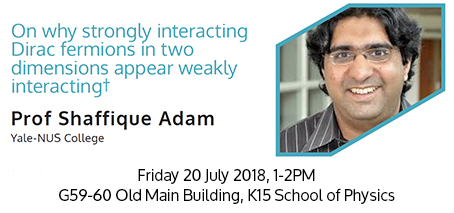-
20 Jul 2018
1:00 pm - 2:00 pm
Why do strongly interacting Dirac fermions in two-dimensions appear weakly interacting?
Shaffique Adam
Yale – National University of Singapore College
All welcome! The seminar flyer can be downloaded here.
About the Speaker:
Shaffique Adam is currently a Associate Professor of Yale-NUS College, a Singaporean National Research Foundation Fellow and also FLEET’s associate investigator. A/Prof Adam is an expert in the theoretical physics of Dirac systems. Within FLEET, he is working on gaining an understanding of the electronic transport and other properties of novel Dirac semimetals, as well as the conventional insulator to topological insulator transition in such systems. View his Research webpage.
Abstract:
Condensed matter realizations of Dirac fermions are now ubiquitous. The most notable example is single monoatomic sheets of carbon called graphene, where its simplicity and ease of preparation has made it a textbook system to test theoretical models [1]. In this talk, I will address the question of what happens to two-dimensional Dirac fermions in the regime where electron-electron interactions are the dominant relaxation mechanism.
First, using a combination of nonperturbative numerical and analytical techniques that incorporate both the contact and long-range parts of the Coulomb interaction, we identify the two previously discussed regimes: a Gross-Neveu transition to a strongly correlated Mott insulator, and a semi-metallic state with a logarithmically diverging Fermi velocity accurately described by the random phase approximation. We predict that experimental realizations of Dirac fermions span this crossover, and this determines whether the Fermi velocity is increased or decreased by interactions. Paradoxically, the more strongly interacting the Dirac fermion is to begin with, the closer it resembles the non-interacting theory upon renormalization [2].
Within this framework, we will then discuss applications of the theory to several open questions including: (i) solving the long-standing mystery of why the observed Fermi velocity in graphene is consistently about 20 percent larger than values obtained from ab initio calculations, (ii) explaining the observed universal renormalization of the Fermi surface anisotropy of composite Fermions at half-filing [3], and (iii) speculating about the recent observation of superconductivity in twisted graphene moiré superlattices.
[1] S. Das Sarma, S. Adam, E. H. Hwang, and E. Rossi, “Electronic transport in two dimensional graphene”, Rev. Mod. Phys. 83, 407 (2011).[2] H. Tang, J.N. Leaw, J.N.B. Rodrigues, I. F. Herbut, P. Sengupta, F.F. Assaad, and S. Adam, “ The role of electron-electron interactions in two-dimensional Dirac fermions”, Science, accepted (2018).
[3] J. N. Leaw, H.K. Tang, M. Trushin, F. F. Assaad, S. Adam and S. Das Sarma. “Universality of Fermi surface anisotropy for interacting Dirac fermions”. Manuscript in preparation, (2018).
Venue: G59-G60, Old Main Building K15
Address:

